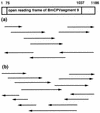Determination of the nucleotide sequence of Bombyx mori cytoplasmic polyhedrosis virus segment 9 and its expression in BmN4 cells
- PMID: 9621035
- PMCID: PMC110377
- DOI: 10.1128/JVI.72.7.5762-5768.1998
Determination of the nucleotide sequence of Bombyx mori cytoplasmic polyhedrosis virus segment 9 and its expression in BmN4 cells
Abstract
Cloning and sequencing of segment 9 of Bombyx mori cytoplasmic polyhedrosis virus (BmCPV) strains H and I were performed. The segment consisted of 1,186 bp harboring 5' and 3' noncoding regions and an open reading frame from positions 75 to 1037, encoding a protein with 320 amino acids, termed NS5. Comparison of the nucleotide sequences of NS5 for the two strains indicated 37 point differences resulting in only six amino acid replacements. Homology search showed that NS5 has localized similarities to human poliovirus RNA-dependent RNA polymerase and human rotavirus NS26. By Western blot analysis, NS5 was found in BmCPV-infected midgut cells, but not in polyhedra or virus virions, and was mainly detectable in the nucleus in BmCPV-infected BmN4 cells. Immunoblot analysis with anti-NS5 and antipolyhedrin antibodies displayed marked differences in the period of expression of NS5 and polyhedrin: the polyhedrin molecule was first detected 2 or 3 days after infection with BmCPV, whereas the expression of NS5 was initiated within a few hours. In addition, the level of polyhedrin increased as the infection developed, whereas the amount of NS5 remained essentially constant. When segment 9 was expressed with a baculovirus expression system, the resulting NS5 protein possessed the ability to bind to the double-stranded RNA genome. These results suggest that NS5 is expressed in early stages of infection and contributes to regulation of genomic RNA function.
Figures








Similar articles
-
Inhibition of miR-274-3p increases BmCPV replication by regulating the expression of BmCPV NS5 gene in Bombyx mori.Virus Genes. 2017 Aug;53(4):643-649. doi: 10.1007/s11262-017-1466-7. Epub 2017 May 10. Virus Genes. 2017. PMID: 28493152
-
Molecular characterization of Bombyx mori cytoplasmic polyhedrosis virus genome segment 4.J Virol. 2001 Jan;75(2):988-95. doi: 10.1128/JVI.75.2.988-995.2001. J Virol. 2001. PMID: 11134312 Free PMC article.
-
Nucleotide sequence of Bombyx mori cytoplasmic polyhedrosis virus segment 8.Biochem Biophys Res Commun. 1998 Jun 29;247(3):549-53. doi: 10.1016/s0006-291x(98)80004-1. Biochem Biophys Res Commun. 1998. PMID: 9657006
-
Effect of mutations on the intracellular localization of Bombyx mori cytoplasmic polyhedrosis virus polyhedrin.J Gen Virol. 1996 Jan;77 ( Pt 1):147-53. doi: 10.1099/0022-1317-77-1-147. J Gen Virol. 1996. PMID: 8558123
-
Characterizations of natural and induced polyhedrin gene mutants of Bombyx mori cytoplasmic polyhedrosis viruses.Arch Virol. 1998;143(2):241-8. doi: 10.1007/s007050050283. Arch Virol. 1998. PMID: 9541610
Cited by
-
Genomic and biological characterization of a new cypovirus isolated from Dendrolimus punctatus.PLoS One. 2014 Nov 24;9(11):e113201. doi: 10.1371/journal.pone.0113201. eCollection 2014. PLoS One. 2014. PMID: 25419713 Free PMC article.
-
Inhibition of miR-274-3p increases BmCPV replication by regulating the expression of BmCPV NS5 gene in Bombyx mori.Virus Genes. 2017 Aug;53(4):643-649. doi: 10.1007/s11262-017-1466-7. Epub 2017 May 10. Virus Genes. 2017. PMID: 28493152
-
Crystal structure and nucleic acid binding mode of CPV NSP9: implications for viroplasm in Reovirales.Nucleic Acids Res. 2024 Oct 14;52(18):11115-11127. doi: 10.1093/nar/gkae803. Nucleic Acids Res. 2024. PMID: 39287123 Free PMC article.
-
Molecular characterization of Bombyx mori cytoplasmic polyhedrosis virus genome segment 4.J Virol. 2001 Jan;75(2):988-95. doi: 10.1128/JVI.75.2.988-995.2001. J Virol. 2001. PMID: 11134312 Free PMC article.
-
Exogenous gene can be expressed by a recombinant Bombyx mori cypovirus.Appl Microbiol Biotechnol. 2018 Feb;102(3):1367-1379. doi: 10.1007/s00253-017-8667-9. Epub 2017 Dec 6. Appl Microbiol Biotechnol. 2018. PMID: 29214406
References
MeSH terms
Substances
Associated data
- Actions
- Actions
LinkOut - more resources
Full Text Sources
Research Materials

